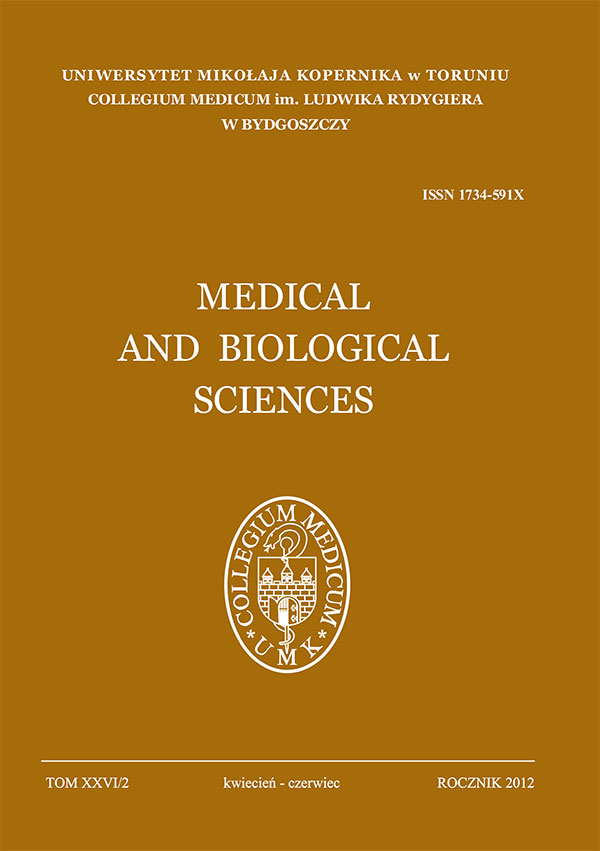Functional evaluation of the lumbosacral spine among athletes practising grappling
DOI:
https://doi.org/10.12775/4062Keywords
grapplingAbstract
Introduction. The lumbosacral spine pain syndromes have become a global problem which transcends the strictly medical sphere. Increased physical activity predisposes in particular the lumbar to overexploitation and exposure to heavy loads and pressures in various planes. In a classic case, a competitor’s injury occurs in the summation of microtraumas and the accelerated wear of tissues, which leads to serious consequences, is the highest price for the intensive improvement of the athlete’s movements.
Aim of the study. The aim of the thesis is to investigate the frequency and intensity of pain of the LS spine among people who practice grappling at various levels. On the basis of the survey, we answer the question whether the intense, specific activity of the athlete has an influence on the occurrence of pain and the motion range of the lumbosacral spine.
Material and methodology. The study involved the total of 20 subjects, including 10 selected national team competitors in grappling and 10 amateur grapplers from the Association of Brazilian Jiu-Jitsu "Gracie Barra" Toruń. The entire study consisted of: questionnaires, measurements of mobility of the LS spine and exercises done by athletes according to the FMS method.
Results. 75% of all respondents felt pain in the LS spine (N = 8 amateurs, N = 7 members of national team). The intensity of symptoms was similar in both groups, but frequency was significantly higher in the amateurs. No correlation between the occurrence of pain and limited range of the LS spine motion was found. No functional abnormalities within that segment were found.
Conclusions. 1. Despite the greater intensity and frequency of training, members of the national grappling team feel the pain in the LS spine less often than amateurs. A complementary training played a significant role in reducing the symptoms. 2. The occurrence of a lower spine pain of the respondents does not have any effect on the limitation of motion range in the LS spine. This risk increases with age and the training duration. 3. The grappling trainings predispose to occurrence of pain complaints among athletes.
References
Garlicki J., Bielecki A., Kuś W. M.: Urazy sportowe u progu trzeciego tysiąclecia. Medycyna Sportowa, nr 114 Traumatologia sportowa; 2001; 01.
Cypress B.: Characteristics of physician visits for back symptoms: a national perspective. An. J. Public. Health., 1983; 73: 389-395.
Dziak A., Tayara S.: Urazy i uszkodzenia w sporcie, Wydawnictwo Kasper, Kraków 2000.
Dziak A.: Bolesny krzyż. Medicina Sportiva, Kraków 2003.
Lennard T., A. Crabtree M. H.: Spine In Sports. Elsevier 2005. http://gateway.webofknowledge.com/gateway/Gateway.cgi?GWVersion=2&SrcApp=PARTNER_APP&SrcAuth=LinksAMR&KeyUT=000305856200009&DestLinkType=FullRecord&DestApp=ALL_WOS&UsrCustomerID=b7bc2757938ac7a7a821505f8243d9f3
Zajączkowski Z.: Medycyna Sportowa w praktyce. PZWL, Warszawa 1984.
Żytkowski A.: Etiopatogeneza bólowych zespołów kręgosłupa lędźwiowo-krzyżowego. Balneologia Polska, 2001; 1: 81-87.
Cook G., Burton L., Hoogenboom B.: Pre-participation screening: The use of fundamental movements as an assessment of function - part 1. North American Journal of Sports Physical Therapy, 2(1): 62-72, 2006.
Cook G., Burton L., Hoogenboom B.: Pre-participation screening: The use of fundamental movements as an assessment of function - part 2. North American Journal of Sports Physical Therapy, 2(1): 132-139, 2006.
Starosta W.: Kształt kręgosłupa z punktu widzenia motoryki człowieka i motoryki sportowej. Postępy rehabilitacji, Vol. VII 1993; 4: 19-32.
Pappas E.: Boxing, wrestling, and martial arts related injuries treated in emergency departments in the United States, 2002-2005. Journal of Sports Science and Medicine, 6: 58-61, 2007.
Cook G.: Baseline sports-fitness testing. In: Foran B, ed. High-performance sports conditioning. Champaign, IL: Human Kinetics; 2001:19-55.
Published
How to Cite
Issue
Section
Stats
Number of views and downloads: 0
Number of citations: 0



